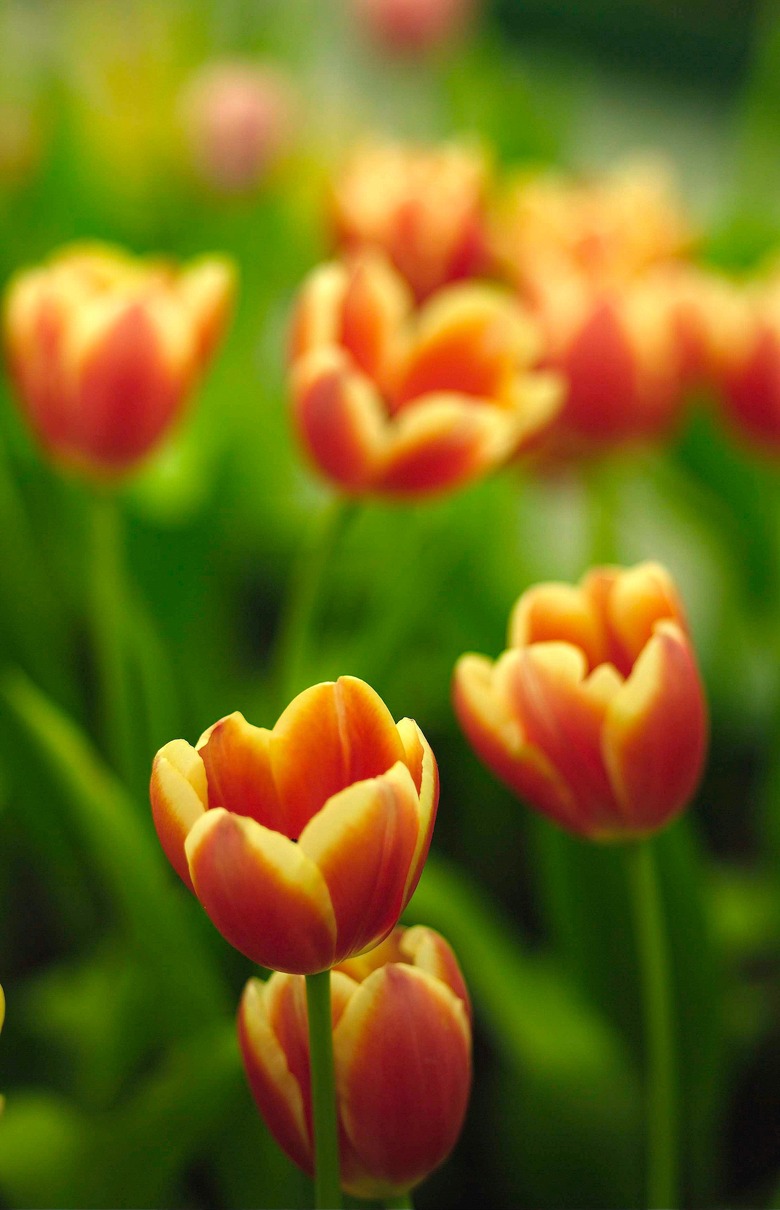Does Weed-B-Gon Kill Tulip Bulbs In The Ground Under The Weeds?
The tulips have faded and the dead foliage is surrounded by weeds. While you might consider using an herbicide in the flowerbed, such as Weed-B-Gon, the manufacturer doesn't recommend this product for use on bulbs. Whether your tulips are growing actively or dormant, you risk killing your flowers if you use dicamba or triclopyr products on the weeds.
Step 1
Tulips (Tulipa spp.) are hardy in U.S. Department of Agriculture plant hardiness zones 4 through 10. While you can leave tulips in the soil, they need chilling while dormant to produce a good show of blossoms in spring. If you plan to use Weed-B-Gon in the flower beds, it's best to dig up all the tulips after they've bloomed and the foliage has died. If you live in USDA zones 8 through 10, store the tulip bulbs in a cool location, such as a refrigerator, where they're exposed to temperatures between 40 and 45 degrees Fahrenheit for 12 to 16 weeks.
Applying Weed-B-Gon
Step 1
After removing the tulip bulbs and other desirable plants from the garden bed, apply a Weed-B-Gon product to the actively growing weeds. Wait for a calm day when temperatures are between 45 and 90 degrees Fahrenheit. Mix 2 to 4 tablespoons for every 1 gallon of water when using a Weed-B-Gon concentrate to cover 500 square feet of garden bed. Wear long sleeves and pants, gloves, safety glasses and a breathing mask whenever applying herbicides to the garden.
Step 2
- are hardy in U.S. Department of Agriculture plant hardiness zones 4 through 10.
- If you live in USDA zones 8 through 10, store the tulip bulbs in a cool location, such as a refrigerator, where they're exposed to temperatures between 40 and 45 degrees Fahrenheit for 12 to 16 weeks.
Alternate Weed-Killing Methods
Step 1
If digging up the tulip bulbs isn't feasible, consider applying a ready-to-use glyphosate product to the actively growing weeds after the tulip foliage has died back completely. Spray the weeds' leaves with glyphosate on a warm, windless day to kill them down to the roots. Avoid spraying desirable plants, since glyphosate is an indiscriminate herbicide. Organic gardeners may prefer to use soil solarization to kill weeds in sunny gardens. Mow or cut the weeds down to the ground, then water thoroughly and cover the soil with clear plastic sheeting. Cover the edges with rocks or boards to hold the plastic in place for four to six weeks, until all the weeds have died.
Replanting Your Tulips
Step 1
Wait three to four months to allow the herbicide to dissipate before replanting your tulip bulbs. Tulips normally are planted in the fall for spring blossoms. Before replanting, add 2 to 4 inches of well-decomposed compost to the garden and dig it in to a depth of 12 inches. Also, add 2 to 3 pounds of a 5-10-10 slow-release fertilizer for every 100 square feet of garden bed. Plant the tulips 6 to 8 inches deep and 6 inches apart in your sunny, well-drained garden. Add a 3- to 4-inch layer of mulch over the soil to help prevent new weed seeds from sprouting.
Step 2
- If digging up the tulip bulbs isn't feasible, consider applying a ready-to-use glyphosate product to the actively growing weeds after the tulip foliage has died back completely.
References
- Scotts Miracle-Gro: Ortho Weed-B-Gon Chickweed, Clover and Oxalis Killer for Lawns
- National Gardening Association: How-To Project — Planting Tulips
- University of California Vegetable Research and Information Center: Soil Solarization A Nonpesticidal Method for Controlling Diseases, Nematodes and Weeds
- Yard & Garden Brief: Spring Flowering Bulbs
